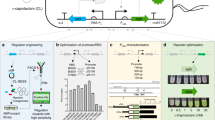Abstract
A novel biosensor strain (Escherichia coli ALM403) that responded to N-acyl homoserine lactone (AHL) was constructed using a luxR-Plux cassette as a regulatory sequence and β-mannanase as a reporter gene. Dinitrosalicylic acid method was used to detect the response of the sensor strain to N-acyl homoserine lactone. By investigating the response to a range of concentrations of N-β-oxooctanoyl-l-homoserine lactone (OOHL), it was demonstrated that the expression of mannanase in E. coli ALM403 could be greatly enhanced by OOHL and resulted in an assayable phenotype. A high-throughput screening approach was developed to isolate AHL-degrading microorganisms, and a marine Halomonas sp. S66-4 showing a marked AHL-degrading ability was successfully isolated. In conclusion, the bioassay system provided a simple and efficient approach to isolate AHL-degrading bacteria.



Similar content being viewed by others
References
Fuqua, W., Winans, S., & Greenberg, E. (1994). Journal of Bacteriology, 176, 269–275.
de Kievit, T., & Iglewski, B. (2000). Infection and Immunity, 68, 4839–4849.
Dong, Y., Wang, L., Xu, J., Zhang, H., Zhang, X., & Zhang, L. (2001). Nature, 411, 813–817.
Dong, Y., Xu, J., Li, X., & Zhang, L. (2000). Proceedings of the National Academy of Sciences of the United States of America, 97, 3526–3531.
Lin, Y., Xu, J., Hu, J., Wang, L., Ong, S., Leadbetter, J., et al. (2003). Molecular Microbiology, 47(3), 849–60.
Czajkowski, R., & Jafra, S. (2009). Acta Biochimica Polonica, 56(1), 1–16.
Zhu, J., Chai, Y., Zhong, Z., Li, S., & Winans, S. (2003). Applied and Environmental Microbiology, 69, 6949–6953.
Winson, M., Swift, S., Fish, L., Throup, J., Jorgensen, F., Chhabra, S., et al. (1998). FEMS Microbiology Letters, 163, 185–192.
Andersen, J., Heydorn, A., Hentzer, M., Eberl, L., Geisenberger, O., Christensen, B., et al. (2001). Applied and Environmental Microbiology, 67, 575–585.
McClean, K., Winson, M., Fish, L., Taylor, A., Chhabra, S., Camara, M., et al. (1997). Microbiology, 143, 3703–3711.
Steindler, L., & Venturi, V. (2007). FEMS Microbiology Letters, 266, 1–9.
Shaw, P., Ping, G., Daly, S., Cha, C., Cronan, J., Rinehart, K., et al. (1997). Proceedings of the National Academy of Sciences of the United States of America, 94, 6036–6041.
Seo, M., Lee, B., Pyun, Y., & Park, H. (2011). Bioscience, Biotechnology, and Biochemistry, 75(9), 1789–95.
Mei, G., Yan, X., Turak, A., Luo, Z., & Zhang, L. (2010). Applied and Environmental Microbiology, 76(15), 4933–4942.
Jafra, S., & van der Wolf, J. (2004). Journal of Microbiological Methods, 57, 415–420.
Dhawan, S., & Kaur, J. (2007). Critical Reviews in Biotechnology, 27, 197–216.
Miller, G. (1959). Analytical Chemistry, 31, 426–428.
Zhang, L., Murphy, P., Kerr, A., & Tate, M. (1993). Nature, 362, 446–448.
Cha, C., Gao, P., Chen, Y., Shaw, P., & Farrand, S. (1998). Molecular Plant-Microbe Interactions, 11, 1119–1129.
Acknowledgments
This work was supported by a grant from the National Natural Sciences Foundation of China (u1170303). The authors would like to thank Prof. Qifa Zhang (National Center of Plant Gene Research, PRC) for providing many useful suggestions, Dr. Paul Williams (University of Nottingham, UK) for supplying plasmid pSB403, and Dr. Lianhui Zhang (Institute of Molecular and Cell Biology, Singapore) for providing the sensor strain of A. tumefaciens, strain NT1 (traR; tra::lacZ749).
Author information
Authors and Affiliations
Corresponding author
Rights and permissions
About this article
Cite this article
Liu, P., Gao, Y., Huang, W. et al. A Novel Bioassay for High-Throughput Screening Microorganisms with N-acyl Homoserine Lactone Degrading Activity. Appl Biochem Biotechnol 167, 73–80 (2012). https://doi.org/10.1007/s12010-012-9653-4
Received:
Accepted:
Published:
Issue Date:
DOI: https://doi.org/10.1007/s12010-012-9653-4




